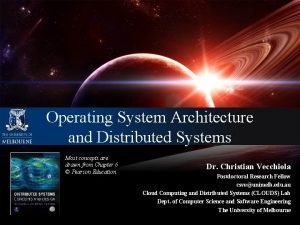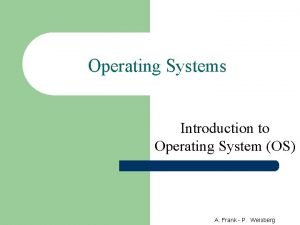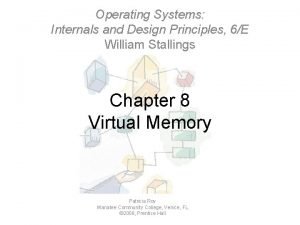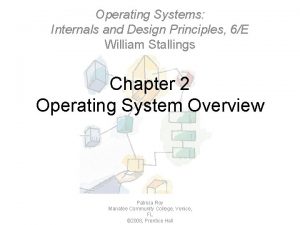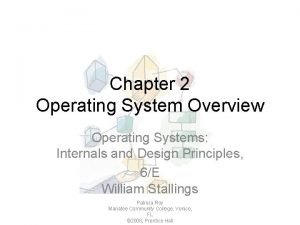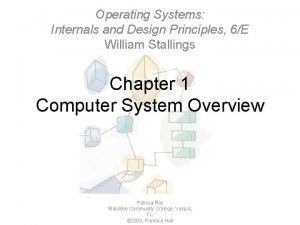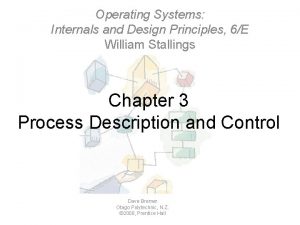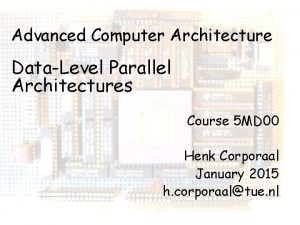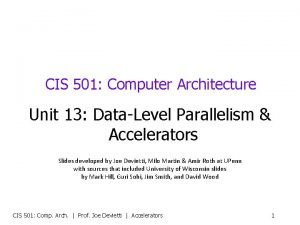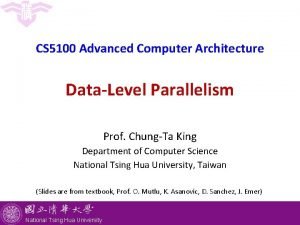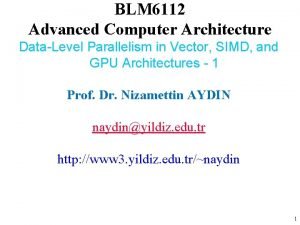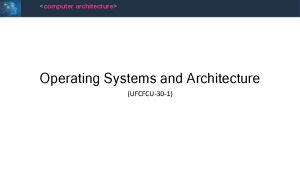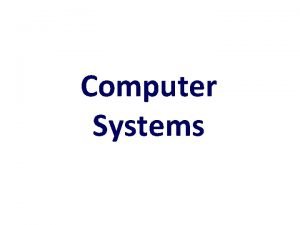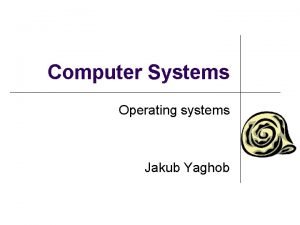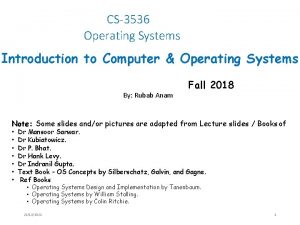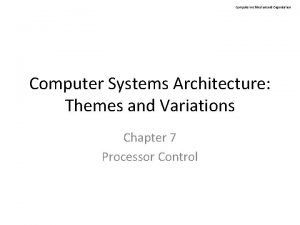Computer Architecture and Operating Systems Lecture 13 Datalevel
















- Slides: 16

Computer Architecture and Operating Systems Lecture 13: Data-level parallelism: Vector, SIMD, GPU Andrei Tatarnikov atatarnikov@hse. ru @andrewt 0301

Data-Level Parallelism § Data-level parallelism is parallelism achieved by performing the same operation on independent data § Best in dealing with arrays in for loops and processing other kinds of identically structured data § Unsuitable for control flow structures 2

Instruction and Data Streams § An alternate classification Data Streams Single Instruction Single Streams Multiple SISD: Intel Pentium 4 Multiple SIMD: SSE instructions of x 86 MISD: MIMD: No examples today Intel Xeon e 5345 § SPMD: Single Program Multiple Data § A parallel program on a MIMD computer § Conditional code for different processors 3

Types of Parallel Processing § Single instruction, single data (SISD) stream: A single processor executes a single instruction stream to operate on data stored in a single memory. Uniprocessors fall into this category. § Single instruction, multiple data (SIMD) stream: A single machine instruction controls the simultaneous execution of a number of processing elements on a lockstep basis. Each has an associated data memory, so that instructions are executed on different sets of data by different processors. Vector and array processors fall into this category. § Multiple instruction, single data (MISD) stream: A sequence of data is transmitted to a set of processors, each of which executes a different instruction sequence. Not commercially implemented. § Multiple instruction, multiple data (MIMD) stream: A set of processors simultaneously execute different instruction sequences on different data sets. SMPs, clusters, and NUMA systems fit into this category. 4

Vector Processors § Highly pipelined function units § Stream data from/to vector registers to units § Data collected from memory into registers § Results stored from registers to memory § Example: Vector extension to RISC-V § v 0 to v 31: 32 × 64 -element registers, (64 -bit elements) § Vector instructions § fld. v, fsd. v: load/store vector § fadd. d. v: add vectors of double § fadd. d. vs: add scalar to each element of vector of double § Significantly reduces instruction-fetch bandwidth 5

Example: DAXPY (Y = a × X + Y) § Conventional RISC-V code: fld addi loop: fld fmul. d fld fadd. d fsd addi bltu f 0, a(x 3) x 5, x 19, 512 f 1, 0(x 19) f 1, f 0 f 2, 0(x 20) f 2, f 1 f 2, 0(x 20) x 19, 8 x 20, 8 x 19, x 5, loop # # # # # load scalar a end of array X load x[i] a * x[i] load y[i] a * x[i] + y[i] store y[i] increment index to x increment index to y repeat if not done # # # load scalar a load vector x vector-scalar multiply load vector y vector-vector add store vector y § Vector RISC-V code: fld. v fmul. d. vs fld. v fadd. d. v fsd. v f 0, a(x 3) v 0, 0(x 19) v 0, f 0 v 1, 0(x 20) v 1, v 0 v 1, 0(x 20) 6

Vector vs. Scalar § Vector architectures and compilers § Simplify data-parallel programming § Explicit statement of absence of loop-carried dependences § Reduced checking in hardware § Regular access patterns benefit from interleaved and burst memory § Avoid control hazards by avoiding loops § More general than ad-hoc media extensions (such as MMX, SSE) § Better match with compiler technology 7

SIMD § Operate elementwise on vectors of data § E. g. , MMX and SSE instructions in x 86 § Multiple data elements in 128 -bit wide registers § All processors execute the same instruction at the same time § Each with different data address, etc. § Simplifies synchronization § Reduced instruction control hardware § Works best for highly data-parallel applications 8

Vector vs. Multimedia Extensions § Vector instructions have a variable vector width, multimedia extensions have a fixed width § Vector instructions support strided access, multimedia extensions do not § Vector units can be combination of pipelined and arrayed functional units: 9

GPU Architectures § Processing is highly data-parallel § GPUs are highly multithreaded § Use thread switching to hide memory latency § Less reliance on multi-level caches § Graphics memory is wide and high-bandwidth § Trend toward general purpose GPUs § Heterogeneous CPU/GPU systems § CPU for sequential code, GPU for parallel code § Programming languages/APIs § Direct. X, Open. GL § C for Graphics (Cg), High Level Shader Language (HLSL) § Compute Unified Device Architecture (CUDA) 10

History of GPUs § Early video cards § Frame buffer memory with address generation for video output § 3 D graphics processing § Originally high-end computers (e. g. , SGI) § Moore’s Law lower cost, higher density § 3 D graphics cards for PCs and game consoles § Graphics Processing Units § Processors oriented to 3 D graphics tasks § Vertex/pixel processing, shading, texture mapping, rasterization 11

Example: NVIDIA Fermi § Multiple SIMD processors, each as shown: 12

Example: NVIDIA Fermi § SIMD Processor: 16 SIMD lanes § SIMD instruction § Operates on 32 element wide threads § Dynamically scheduled on 16 -wide processor over 2 cycles § 32 K x 32 -bit registers spread across lanes § 64 registers per thread context 13

GPU Memory Structures 14

Concluding Remarks § SIMD and vector operations match multimedia applications and are easy to program 15

Any Questions? __start: cycle: if_less: done: . text addi t 1, zero, 0 x 18 addi t 2, zero, 0 x 21 beq t 1, t 2, done slt t 0, t 1, t 2 bne t 0, zero, if_less nop sub t 1, t 2 j cycle nop sub t 2, t 1 j cycle add t 3, t 1, zero 16
 Operating systems lecture notes
Operating systems lecture notes Architecture lecture notes
Architecture lecture notes Isa computer architecture
Isa computer architecture What is operating system architecture
What is operating system architecture 01:640:244 lecture notes - lecture 15: plat, idah, farad
01:640:244 lecture notes - lecture 15: plat, idah, farad Computer architecture and organization difference
Computer architecture and organization difference Bus architecture in computer architecture
Bus architecture in computer architecture Basic computer organization
Basic computer organization Can we make operating systems reliable and secure
Can we make operating systems reliable and secure Operating system internals and design principles
Operating system internals and design principles Module 4 operating systems and file management
Module 4 operating systems and file management Operating systems: internals and design principles
Operating systems: internals and design principles Operating systems: internals and design principles
Operating systems: internals and design principles Operating systems: internals and design principles
Operating systems: internals and design principles Operating systems: internals and design principles
Operating systems: internals and design principles Operating systems internals and design principles
Operating systems internals and design principles Operating system internals and design principles
Operating system internals and design principles



